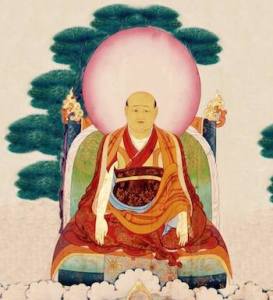Introduction

Dza Patrul Rinpoche, Orgyen Chökyi Wangpo
In his account of the famous debate between Ju Mipham Namgyal Gyatso (’ju mi pham rnam rgyal rgya mtsho, 1846-1912) and Alak Dongak Gyatso (a lags mdo sngags rgya mtsho, 1824–1902),[1] Khetsun Sangpo Rinpoche tells us that Alak Dongak was so upset at losing the contest and seeing his treatise on Dzogchen burned in front of his teacher, Patrul Rinpoche (rdza dpal sprul o rgyan chos kyi dbang po, 1808-1887), that he broke down and wept.[2]
When I recently asked Tulku Thondup Rinpoche about this, he mentioned another possible explanation for Alak Dongak’s distress:
Khenpo Chemchok, my own teacher, used to say that on one occasion Könme Khenpo, my predecessor, asked Alak Dongak if it was true that he had cried after the debate with Mipham. Yes, he replied, he had wept, but it was not because he had lost the argument. In fact, he said, he had cried because Patrul Rinpoche had chastised him. Whenever he was winning, he said, Patrul would say to him, “I told you to meditate on love and compassion, but instead you’ve filled your head with all this scholarly stuff!” Yet whenever Mipham was winning, Patrul Rinpoche said nothing. Alak Dongak told Patrul, “I didn’t neglect your instructions. I have meditated on bodhicitta.” But it was the accusation of failing to apply his teacher’s instructions, he said, and not the humiliation of losing, that made him weep.
Continue reading →
 This post is no more than a quick note to provide the dates of Rogza Sönam Palge (rog bza’ bsod nams dpal dge), who is known primarily as a teacher of yogic practices (tsa-lung) to Patrul Rinpoche (1808–1887) and also as one of the gurus of Orgyen Tendzin Norbu (1841–1900). As far as I’m aware, his dates have never appeared in any English-language publication. Indeed, he doesn’t even have an entry on tbrc.org
This post is no more than a quick note to provide the dates of Rogza Sönam Palge (rog bza’ bsod nams dpal dge), who is known primarily as a teacher of yogic practices (tsa-lung) to Patrul Rinpoche (1808–1887) and also as one of the gurus of Orgyen Tendzin Norbu (1841–1900). As far as I’m aware, his dates have never appeared in any English-language publication. Indeed, he doesn’t even have an entry on tbrc.org


 For English-reading fans of Dza Patrul Rinpoche (rdza dpal sprul rin po che, 1808–1887) these are bountiful times. July saw the publication of Matthieu Ricard’s collection of stories and texts,
For English-reading fans of Dza Patrul Rinpoche (rdza dpal sprul rin po che, 1808–1887) these are bountiful times. July saw the publication of Matthieu Ricard’s collection of stories and texts,  I imagine that most readers of this blog will be as keen as I am to read Matthieu Ricard’s forthcoming book,
I imagine that most readers of this blog will be as keen as I am to read Matthieu Ricard’s forthcoming book, 
 Amongst the many things Tibetans inherited from India was a sense that names, when applied to exalted beings, are far more than mere verbal labels aiding identification. Deities’ names capture something of their essence, and reciting them is a form of invocation and praise. Most mantras have names at their heart, and there are whole texts, such as Mañjuśrī–nāma-saṃgīti (Reciting the Names of Mañjuśrī), devoted to lists of alternative names or epithets.
Amongst the many things Tibetans inherited from India was a sense that names, when applied to exalted beings, are far more than mere verbal labels aiding identification. Deities’ names capture something of their essence, and reciting them is a form of invocation and praise. Most mantras have names at their heart, and there are whole texts, such as Mañjuśrī–nāma-saṃgīti (Reciting the Names of Mañjuśrī), devoted to lists of alternative names or epithets.
You must be logged in to post a comment.